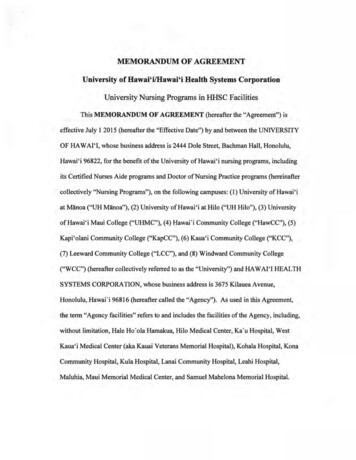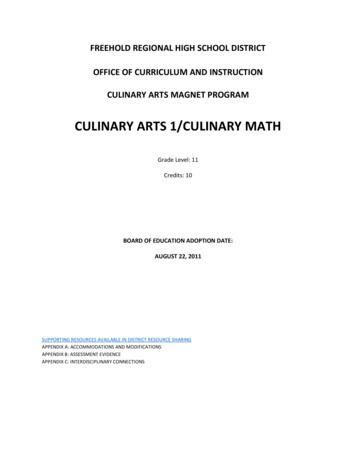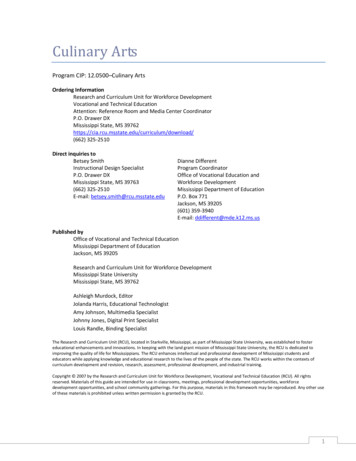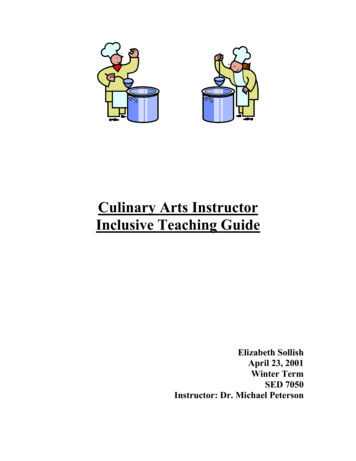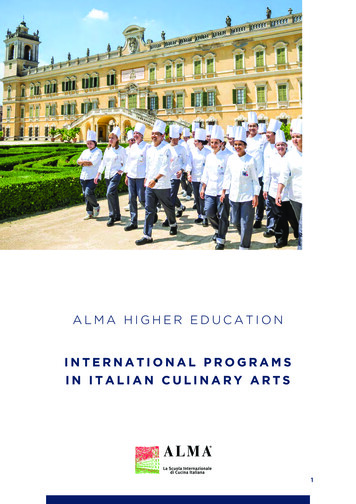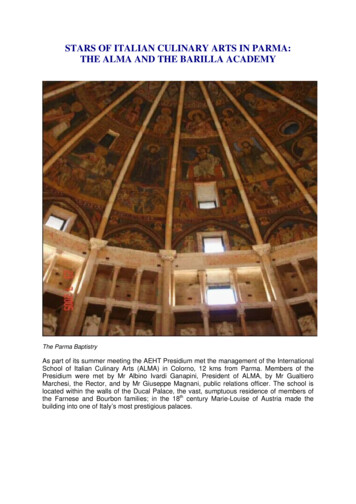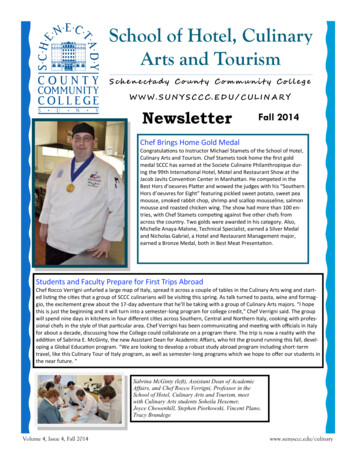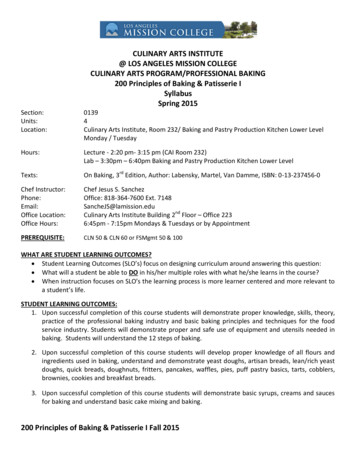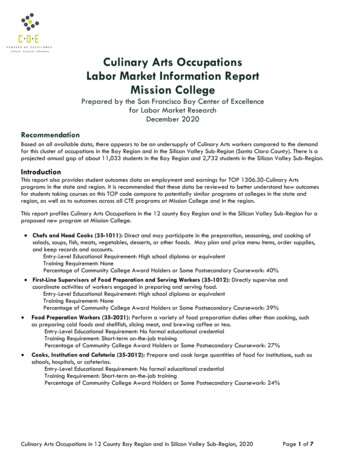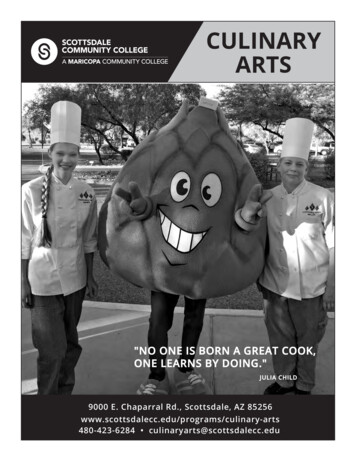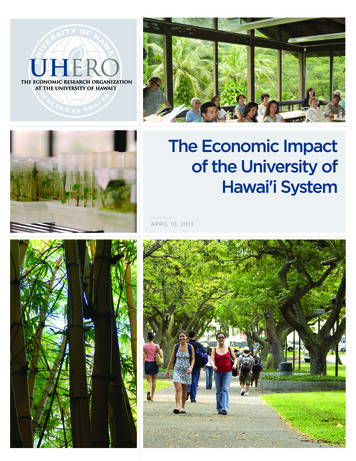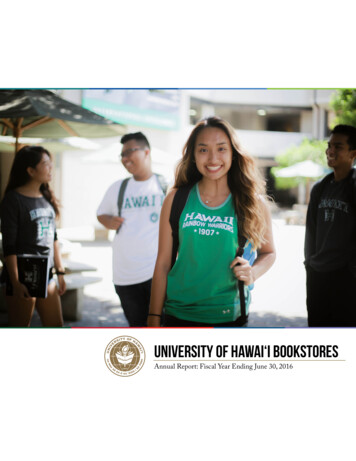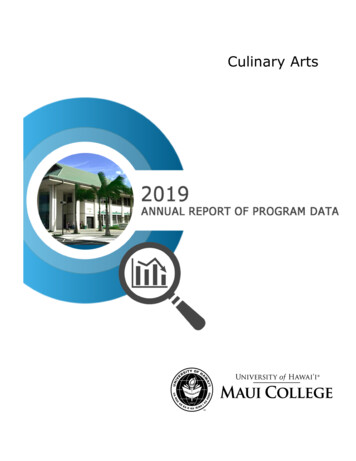
Transcription
Culinary Arts
2019 University of Hawai'i Maui College ARPDProgram: Culinary Arts1. Program Descriptiona) Statement and brief description of the program including a listing of the program levelStudent Learning Outcomes (SLOs).b) Program MissionProgram MissionThe mission and goals of the UH Maui College Culinary Arts Program directlyalign with the philosophy of the college as well as industry standards:UH Maui College Culinary Arts Program Mission Statement: Our mission is to teach in a nurturingstudent-centered environment. Our charge is to prepare our students for success in life and careerby providing them the foundational skills of our profession. We hope to inspire our students tocelebrate the diversity of food and cultures throughout the world and elevate their knowledge andappreciation of culinary arts.Mission: The University of Hawai‘i Maui College inspires students to develop knowledge and skills inpursuit of academic, career, and personal goals in a supportive educational environment thatemphasizes community engagement, lifelong learning, sustainable living, Native Hawaiian culture,and global understanding.Vision: The University of Hawai‘i Maui College: We will prepare students to respond to emergingchallenges in their lives, communities, and the world through compassion, leadership, problemsolving, and innovation.The Culinary Program’s overall goal is to get students industry ready for entry into culinary arts whilecontinuing to inspire them to pursue a career in the culinary arts that will be as dynamic as it will bechallenging. The Program’s charge aligns with that of the institution’s in that it emphasizescommunity engagement through industry events, bringing in all students regardless of age oreconomic background, while embracing the differences and celebrating cultural diversity.The Program’s commitment to on-going sustainable practices is evident within such efforts as farmto-table offerings, new electrical and LED implementation, and compost and recycling efforts. Inaddition, through the Program’s partnership with Sodexo, a managed services provider, the foodcourt has established policies such as use of only biodegradable to-go containers and a plastic strawban.The Culinary Program fosters the pursuit of academic advancement in a supportive educationalenvironment. As a result of continuous assessment of individual student learning, the programstrives to provide every student with the support they need.Date Program Website Last Reviewed/Updated: Spring 2019Date Program Page Reviewed/Updated in Catalog: Spring 20192
2019 University of Hawai'i Maui College ARPDProgram: Culinary Arts2. Analysis of the Programa) Strengths and weaknesses in terms of demand, efficiency, and effectiveness based onan analysis of the Quantitative Indicators. CTE programs must include an analysis ofPerkins Core indicators for which the program did not meet the performance level.Include Significant Program Actions (new certificates, stop outs, gain/loss of positions,results of prior yearʻs action plan).As interpreted in the ARPD the program is showing healthy in overall quantitative indicators, ofdemand efficiency and effectiveness, what follows is an interpretation of that information.The data shows an increase in demand in majors from 2016-17 of 97 to 103 in 2018-19, and takinginto account an only slight dip of 106 from 2017-18. The SSH (student semester hours) decreasedby only 40 from 2018-19 with a total of 1695 in 2017-18 to 1655 in 2018-19. The program seems tobe holding steady. The full-time students have dropped from 65% in 2017-18 to 56% in 2018-19,which is a direct reflection of industry unemployment, and the jobs available to these students whoare opting to go directly into industry. This is also further supported by the data in the demandindicators showing an increase in part-time students of 10%. This is a direct reflection industry needsand demand for labor in the workforce.The fill rate for classes has virtually stayed the same with a slight fluctuation in class size. This nextyear however, the Culinary Program has made steps to consolidate the class offerings to bring thatnumber back to 2017-18 level.In terms of the FTE BOR appointed 5 faculty designated, the truer picture is 2 of the 5 have beenreassigned for over 3 ½ years and the Program has been operating with only 3. Even though thesystem recognizes the 5 and the analytic number shows 6, the Program is surviving with the 3 inhopes of the two positions returning to the program eventually. The number of FTE faculty isaccording to the 5, however if one was to calculate from the position of only 3 it would show not the21 as indicated but a larger number. from this perspective, and complexities of running labs and foodcosts, this puts an extra burden on the FTE BOR faculty to take on many layers that are not requiredfrom programs on campus without the rigorous demands of a robust culinary program.In theory, and as indicated, the program should have 6 not 5 FTE BOR appointed faculty or for thatmatter. It The fact that the program has been operating like this for some time, it weakens theoverall effectiveness of the program, and happens to be why the program has relied heavily onlecturers to supplement and run some of the under enrolled classes.The effectiveness indicators have relatively stayed the same, while also showing the “W” on the risewhich, in part, shows an increased participation in the early alert system. Persistence has stayedrelatively the same and the degrees awarded have increased from 20 in 2017-18 to 29 2018-19.Perkins indicators were all met.The Culinary Program went through a rigorous accreditation Spring of 2019 of our accrediting bodythe American Culinary Federation Education Foundation Accrediting Commission (ACFEFAC). As aresult of that accreditation the Program received 5 years, which was in line with our sister campus’Kapiolani, Kona, and Hilo. The rigorous process of highlighting out Program Learning Outcomes,Student Learning Outcomes and newer ACF competencies prescribed by the commission, the3
2019 University of Hawai'i Maui College ARPDProgram: Culinary Artsprogram was able to take a deeper dive into what the challenges are faced on this particularcampus. The results from their findings were not of substance and content, but of facilities and lackof continued support in terms of safety and sanitation. The ACFEFAC was quite adamant on some ofthe issues of failing building maintenance. The Program was then able to parlay the commission'sfindings into action strategies in terms of safety and management of the facility moving forward.The commission also noted a list of non-compliance issues which were addressed and sent back tothe commission for approval. We have since modified our outreach portion of the Program to reflectthe discrepancies found by the commission.b) Discuss course offering modality including online, hybrid, and skybridge.The Program offers two online classes, CULN 112 online and live and CULN 115 online.The online 112 of safety and sanitation give the students a chance to retake this classin a mode that would not interfere with the lab classes if they so choose.c) Highlight new innovative student support efforts including FYE, etc.FYE course-CULN 111--lecturer received training to incorporate FYE strategies (peerconnection, campus connection, academic skill development, and career exploration)into his course.Participation in Early Alert and resulted in increase in W in timely manner to avoidpenalty to studentsA Perkins proposal in the summer of 2019 went out to all the Culinary Program acrossthe state from Leeward Community College to offer a professional development activityto attend and participate in the Certified Hospitality Educator Certification or CHE as it iscalled. The CHE designation recognizes those individuals who have demonstrated thequalities needed to become hospitality educators. The Program was able to send 1 fulltime faculty Craig Omori, and 4 lecturers. The results for certification was 3 received,and 2 need to retake the certification test. Associate Professor Teresa Shurilla hadpreviously received the certification and continues to renew the certification to staycurrent every 5 years.The results from the certification only goes to enhance thestrength of the overall programs effectiveness.Assistant Professor Craig Omori also attended the Innovations Conference in New YorkCity February 24-27 2019, where he met with professionals convening and dedicated toenhancing teaching and learning, leadership and management and their communitycollege experience. The international event provided a forum for collaboration amongacademic experts and thought leaders, while granting participants exclusive access tothe most innovative and inspirational community college programs from around theworld.This is a brief description of his presentation that he gave in NY this past February (andwill be doing so again in Honolulu in January).Are CTE students “succeeding” if they earn a good grade but lack certain skills neededto thrive in the workforce? Participants will explore techniques used to align “industry”and “education” standards in the classroom/lab to better prepare students for4
2019 University of Hawai'i Maui College ARPDProgram: Culinary Artsemployment in the “real world” after college. A grading system that mimics industry byusing earned wages and performance evaluations to develop exemplary professionalbehaviors will be shared. Best practices for providing opportunities to developexemplary professional behaviors will be covered.3. Program Student Learning Outcomesa) List of the Program Student Learning OutcomesCULN PLO 1. Identify and practice the basic principles of culinary service, organization andstructure, sanitation and safety in a food service operation to maintain optimum health andsatisfaction of the consumer.CULN PLO 2. Explain, examine and demonstrate principles and concepts of quality foodprocurement and identification, food and baking preparation and cost controls, service, and properuse of tools and equipment to produce and serve a variety of professional food items.CULN PLO 3. Demonstrate skills in various areas of the culinary hierarchy: human relations,teamwork, leadership, personnel management, and ethical decision making.CULN PLO 4. Discuss the standards of restaurant regulations involving liquor protocol andhealth and safety regulationsCULN PLO 5. Practice standards in behavior, ethics, grooming and dress appropriate toculinary industry professionals.b) Program Student Learning Outcomes that have been assessed in the year of the AnnualReview of Program Data.The Culinary Program assessed its program through the ACF accreditation process thatcycled through 2018-2019. The process included review of all PLO and student evidenceof learning. Results of this process are described above in question 2.The Culinary Program will be transitioning to a new assessment platform, from what weare using now: Livetext, Via. The Program has been using Livetext since 2013 from anearlier Perkins proposal which helped integrate and implemented the LiveTextassessment platformLiveText is an Internet-based subscription service that allows students andinstructors to "create, share, and collaborate on educational curriculum."Get to outcomes-based data more quickly by engaging faculty with user-friendlytools for collecting student work, scoring artifacts, and reporting on assessmentactivities.5
2019 University of Hawai'i Maui College ARPDProgram: Culinary ArtsManage catalog and curriculum in a fully integrated, intuitive solution tostreamline review processes & capture the connections between course data,program requirements, and learning outcomes.Conduct better course evaluations and surveys with features designed to simplifyprocesses for faculty, administrators, and students.Electronic portfolios have served as a valuable learning tool for students. Theprocess of thoughtfully selecting key artifacts illustrating growth and significantlearning milestones engenders a process of self-reflection, proven to be valuableand beneficial to the student. e-Portfolios have evolved significantly, reachingbeyond the student and the learning experience, broadening their benefits tofaculty, administrators, state agencies, accreditation bodies and the labormarket.The differences will be an enhancement of what was already started and enable theprogram to better highlight the date needed, and give the faculty and students a moreuser friendly model in which:Via by Watermark is an online assessment platform which allows instructors toassess student performance in lab, work externship, and assignments. It alsogives students a place to build an online portfolio of their cumulative work in theprogram. By using Via to implement these assessments, the data gathered canbe used for self-study to assess how the program is performing on studentoutcomes. The program can also implement instructional interventions andassess their effectiveness. UHMC Culinary Arts Program is currently undertakinga Perkins Grant funded transition from LiveText, its existing assessmentsoftware, to Via by Watermark.c) Describe the assessment activityThe UHMC Culinary Arts was recently awarded a new Perkins Grant Career andTechnical Education Award from 2019-202 of a total of 49,555, which is titled “LiveTextto Via Assessment Platform Transition”The University of Hawaii Maui College Culinary Arts Program currently uses LiveText byWatermark as the formal assessment tool to monitor student’s achievement in standardAmerican Culinary Federation Education Foundation (ACFEF) competencies and studentlearning outcomes. LiveText was originally purchased by the program through a PerkinsGrant in 2011. The program needs to update and expand its use of online assessmenttools to ensure that every student is receiving the most thorough and up to dateculinary education as they prepare to embark on a career in Food and Beverage.6
2019 University of Hawai'i Maui College ARPDProgram: Culinary ArtsACF competencies have changed significantly.The Culinary Arts Program is currently underwent a re-accreditationprocess with ACFEF. In 2018, the ACFEF revised its list of competencies. Thelist has been consolidated from 306 to 242 competencies. It is a significantchange which needs to be integrated into our assessment platform.In 2018, all five culinary arts programs in the University of Hawaii systemengaged in a course articulation alignment in order to facilitate thematriculation of students and the transfer of courses across the UHCommunity College system.The intent of this project is to create a culture of self-assessment through a cuttingedge assessment tool which allows us to evaluating performance, implement targetedinterventions in the classroom and evaluate the actual results in student learning. Thisspeaks directly to one of the five priorities listed in the UHMC Strategic Plan,assessment and improving the quality of learning. It is our belief that improving thequality and continuity of instruction we offer as a program will positively impactcompletion rates.d) Describe assessment resultsAs a result of the assessment activities, and data capturing that enabled the Program thisSpring during the ACFEF site-visit, the program was able to capture new data through the ACFre-accreditation, and strengthen the competencies and student SLO’s rather than expendingresources updating and correcting obsolete competencies and configuration errors currentlypresent in LiveText, the Culinary Arts Program seeks to transition to Via by Watermark.e) Describe any changes that have been made as a result of the assessments.The following tasks will be undertaken in order to implement the transition to Via: The completely new list of ACFEF competencies to be codified and imported to Via. Restricting administrative access to critical features in order to mitigate futureconfiguration errors. Standardized assessment rubrics to be built across all courses. Elements in rubrics associated with competencies, SLOs and PLOs to ensureaccurate data gathering. Implement workplace behavior assessment system in key lab classes CULN 220,CULN 240, and CULN 271Long term strategies: (estimated years 2 and 3) Implement workplace behavior assessment system in key lab classes CULN 120,CULN 130, CULN 150, CULN 155, CULN 250, and CULN 251. Implement an annual program self-assessment. Instill a culture of self-assessment and perpetual curriculum improvement within the7
2019 University of Hawai'i Maui College ARPDProgram: Culinary Artsculinary arts program.4. Action Plana) Describe the action plan for the next academic year, including resource, curricular,professional development, or other next steps.It was recommended by the ACF Commission that we start a local ACF chapter at thecollege, which is already in negotiations and moving forward headed by AssociateProfessor Teresa Shurilla and Assistant Professor craig Omori. The intent is to try andsubmit a Perkins Proposal to facilitate help in the endeavor. The proposal would be twofold, one it world facilitate the certifications of graduating culinary students in their finalsemester, and also try and certify the faculty and staff through ACF. None of the staffcurrently is ACF certified, one problem the Program hopes to remedy.These certifications will help to strengthen the effectiveness of each instructor by givingthe professional certifications offered by the American Culinary Federation.b) Include how the actions within the plan support the collegeʻs mission. In addition to theoverall action plan for the program, include specific action plans for any Perkins CoreIndicator for which the program did not meet the performance level.All Perkins core indicators were met.5. Resource Implications(physical, human, financial)The Program would like to get the 2 FTE positions back to culinary and also ask for 1more new FTE BOR position which was discussed earlier.This would help in avoiding high lecturer costs which has the lecturers covering the twofull time positions that have been reassigned, and created the instability with adjuncthire and budget cuts.In terms of the program data from Paul, it seems as though the Culinary Program:291.75 Total TEs taught in0 TEs taught by non-CULN BoR instructors0 TEs taught OUT8
2019 University of Hawai'i Maui College ARPDProgram: Culinary Arts1778 total SSH taught from CULN coursesEstimated Tuition Total of 246,347.75Estimated Salary Total 709,0241710 SH taught to CULN majors68 SH taught to Non-CULN majorsFrom the data provided from other programs it looks as though we are one of the moreexpensive programs to run on campus, with a high SSH but the cost of this could be offset bythe faculty positions returning and a consolidating of low enrolled classes, which is what we arealready doing for next Spring 2020 and into fall 2020.9
2019 University of Hawai'i Maui College ARPDProgram: Culinary ArtsAppendix: ARPD data10
2019 University of Hawai'i Maui College ARPDProgram: Culinary Arts11
2019 University of Hawai'i Maui College ARPDProgram: Culinary Arts12
Program Mission Program MissionThe mission and goals of the UH Maui College Culinary Arts Program directly align with the philosophy of the college as well as industry standards: UH Maui College Culinary Arts Program Mission S
